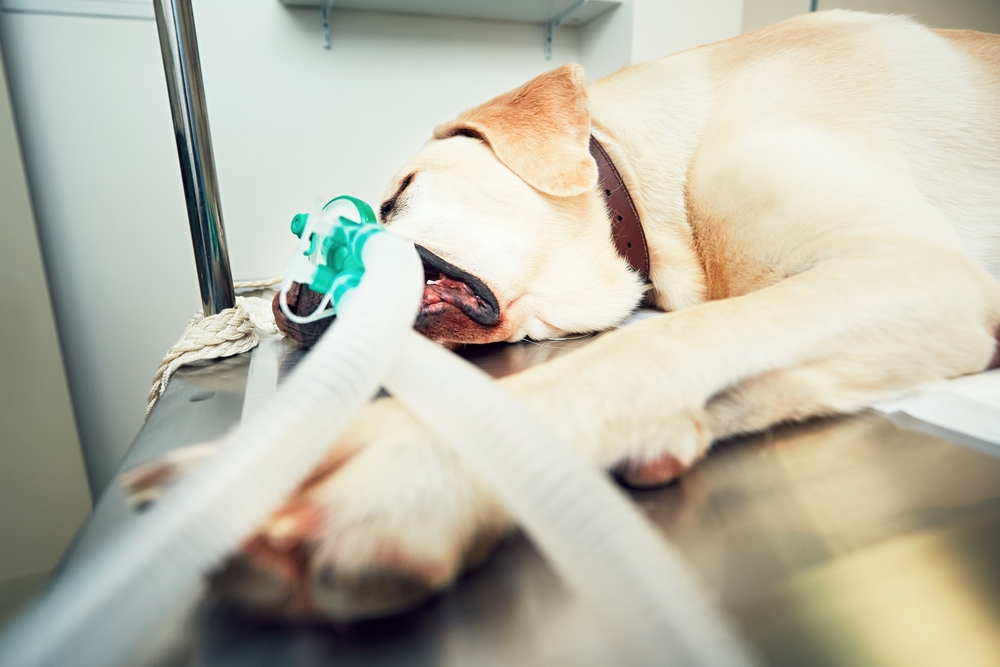The thought of their pet undergoing anesthesia can unsettle a pet owner—largely, from a fear of the unknown. Without knowing exactly what is happening to your pet, and all the ways your Animal Clinic of Council Bluffs team is striving to keep them safe, remaining calm, and trusting in our expertise, skill, and dedication, can be difficult. However, we know you’ve entrusted your pet to our care, and we do our utmost to ensure they remain safe and comfortable during their procedure. To help put your mind at ease, here are five ways—of many—that our team works to keep your pet safe during anesthesia.
#1: We perform a pre-anesthetic exam on your pet the day of their procedure
Although your pet may have had a physical exam a week ago, we will still perform another one the day of their procedure. A lot can change in a few short days, so we always thoroughly examine your pet, to ensure we have the most accurate and current vital signs. We carefully listen to their heart and lungs, take their temperature, and check their gum color to assess their circulation. Abnormalities on a physical exam are evaluated further through blood work, X-rays, and other diagnostic tests, and, if need be, your pet’s anesthetic procedure will be postponed.
#2: We run pre-anesthetic blood work on your pet to check their internal health
While a physical exam imparts valuable information about your pet’s overall health, blood work allows an internal look. For most pets, we run a complete blood count (CBC) and blood chemistry profile. These two tests tell us a lot about how your pet’s body is functioning, and will inform us about:
- Dehydration
- Anemia
- Infection
- Inflammation
- Clotting problems
- Kidney or liver dysfunction
- Electrolyte imbalances
- Blood glucose issues
If your pet’s blood work shows any abnormality, we’ll dig deeper to find the cause of the problem. For example, if your pet’s kidney values are elevated, we’ll recommend a urinalysis, to see how well the kidneys are concentrating urine, or if your pet simply has not drank much today.
#3: We create a customized anesthetic protocol for your pet
Based on the information we gathered through the physical exam and blood work, we’ll formulate a personalized anesthetic protocol that is unique to your pet’s health status and their procedure. Anesthetic protocols and the drugs we use will vary greatly, depending on your pet’s organ function, their anxiety level, and the procedure’s pain level. For example, a foreign body surgery to remove a sock from the intestinal tract will be more painful than snipping a skin tag, and we’ll tailor our anesthetic protocol accordingly.
#4: We place an intravenous catheter in your pet
In the rare event of an emergency, we will want immediate access to your pet’s vein, to administer life-saving drugs. Because of this, we place an intravenous (IV) catheter in every pet undergoing anesthesia. An IV catheter allows us to administer not only medications, but also fluids, which are essential for maintaining a normal blood pressure. Plus, fluid administration helps your pet’s kidneys metabolize and flush out anesthetic drugs more quickly, enabling your pet to recover more rapidly, so they can return home to you sooner.
#5: Our team closely monitors your pet before, during, and after an anesthetic procedure
Before your pet ever goes under anesthesia, our skilled team is already monitoring their vital signs with a variety of monitoring equipment. Watching the patterns of your pet’s vital signs before, during, and after anesthesia helps us spot any subtle changes, and lets us correct an issue before becoming a serious problem. Vital signs we monitor include:

- Heart rate and rhythm
- Respiratory rate and effort
- Blood pressure
- Oxygen and carbon dioxide levels
- Temperature
- Comfort level
- Anesthetic depth
At the first hint of a problem or abnormality in your pet’s values, our highly trained and experienced veterinary technician team will inform our veterinarians of the issue. By working together, we can immediately correct a problem, before becoming serious. However, our monitoring doesn’t end when your pet’s procedure is completed. We regularly check your pet’s vital signs until they are fully recovered from anesthesia, are coherent, and able to walk. Then, your four-legged friend can return home to you.
We understand that the thought of your pet undergoing anesthesia can be scary. Our team knows how much trust you place in us to keep your beloved pet safe, and we do our utmost to ensure they are safe and healthy before, during, and after any anesthetic event. If your pet is scheduled for an upcoming procedure, and you have questions about anesthesia, contact our Animal Clinic of Council Bluffs team.






Leave A Comment